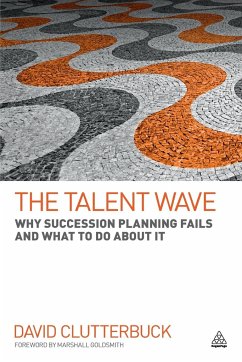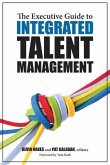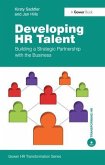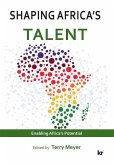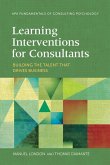- Broschiertes Buch
- Merkliste
- Auf die Merkliste
- Bewerten Bewerten
- Teilen
- Produkt teilen
- Produkterinnerung
- Produkterinnerung
If succession planning works, how do the wrong people so often get to the top? Succession planning was once the key to identifying potential leaders to fill important positions. However, in today's rapidly evolving business world traditional succession planning is no longer a viable strategy with research showing that 70% of succession plans fail within two years, simply from lack of management support. In a climate of growing skills shortages and lack of confidence in leadership potential, David Clutterbuck offers a new a process of dialogue between an organization and its employees. The…mehr
Andere Kunden interessierten sich auch für
![The Executive Guide to Integrated Talent Management The Executive Guide to Integrated Talent Management]() Pat GalaganThe Executive Guide to Integrated Talent Management29,99 €
Pat GalaganThe Executive Guide to Integrated Talent Management29,99 €![Department of the Air Force Officer Talent Management Reforms Department of the Air Force Officer Talent Management Reforms]() Matthew WalshDepartment of the Air Force Officer Talent Management Reforms35,99 €
Matthew WalshDepartment of the Air Force Officer Talent Management Reforms35,99 €![Developing HR Talent Developing HR Talent]() Kirsty SaddlerDeveloping HR Talent65,99 €
Kirsty SaddlerDeveloping HR Talent65,99 €![Attracting and Employing Top-Tier Civilian Technical Talent in the Department of the Air Force Attracting and Employing Top-Tier Civilian Technical Talent in the Department of the Air Force]() Kirsten M KellerAttracting and Employing Top-Tier Civilian Technical Talent in the Department of the Air Force53,99 €
Kirsten M KellerAttracting and Employing Top-Tier Civilian Technical Talent in the Department of the Air Force53,99 €![Hr's Mission Next: Building a Veteran-Informed Culture to Recruit and Retain Top Talent Hr's Mission Next: Building a Veteran-Informed Culture to Recruit and Retain Top Talent]() Kimberlie EnglandHr's Mission Next: Building a Veteran-Informed Culture to Recruit and Retain Top Talent16,99 €
Kimberlie EnglandHr's Mission Next: Building a Veteran-Informed Culture to Recruit and Retain Top Talent16,99 €![Shaping Africa's Talent: Build, develop and retain talent Shaping Africa's Talent: Build, develop and retain talent]() Shaping Africa's Talent: Build, develop and retain talent26,99 €
Shaping Africa's Talent: Build, develop and retain talent26,99 €![Learning Interventions for Consultants: Building the Talent That Drives Business Learning Interventions for Consultants: Building the Talent That Drives Business]() Manuel LondonLearning Interventions for Consultants: Building the Talent That Drives Business53,99 €
Manuel LondonLearning Interventions for Consultants: Building the Talent That Drives Business53,99 €-
-
-
If succession planning works, how do the wrong people so often get to the top? Succession planning was once the key to identifying potential leaders to fill important positions. However, in today's rapidly evolving business world traditional succession planning is no longer a viable strategy with research showing that 70% of succession plans fail within two years, simply from lack of management support. In a climate of growing skills shortages and lack of confidence in leadership potential, David Clutterbuck offers a new a process of dialogue between an organization and its employees. The Talent Wave presents a dynamic, flexible approach to succession planning and talent management. Clutterbuck first demolishes most of accepted practice in these areas, and then presents practical solutions which align employee ambitions and business priorities to ensure that organizations have the right leadership in place for ongoing success.
Hinweis: Dieser Artikel kann nur an eine deutsche Lieferadresse ausgeliefert werden.
Hinweis: Dieser Artikel kann nur an eine deutsche Lieferadresse ausgeliefert werden.
Produktdetails
- Produktdetails
- Verlag: Kogan Page
- Seitenzahl: 256
- Erscheinungstermin: 28. August 2012
- Englisch
- Abmessung: 234mm x 156mm x 15mm
- Gewicht: 395g
- ISBN-13: 9780749456979
- ISBN-10: 0749456973
- Artikelnr.: 35579940
- Herstellerkennzeichnung
- Libri GmbH
- Europaallee 1
- 36244 Bad Hersfeld
- gpsr@libri.de
- Verlag: Kogan Page
- Seitenzahl: 256
- Erscheinungstermin: 28. August 2012
- Englisch
- Abmessung: 234mm x 156mm x 15mm
- Gewicht: 395g
- ISBN-13: 9780749456979
- ISBN-10: 0749456973
- Artikelnr.: 35579940
- Herstellerkennzeichnung
- Libri GmbH
- Europaallee 1
- 36244 Bad Hersfeld
- gpsr@libri.de
Dr. David Clutterbuck is one of Europe's most prolific and well-known management writers and thinkers. He has written 53 books and hundreds of articles on cutting edge management themes. Co-founder of The European Mentoring and Coaching Council, Clutterbuck is a former Practice Lead of an international consulting firm that specializes in helping people in organizations develop the skills to help others. HR Magazine listed him as one of the top 25 most influential thinkers in the field of Human Resources. Dr Clutterbuck is also visiting professor at both Sheffield Hallam University and Oxford Brookes University.
Foreword
Acknowledgements
Introduction
01 What's wrong with succession planning?
What is succession planning?
Models of succession planning
Key themes in succession planning
How organizations go about succession planning
Effective succession planning
Evaluating the effectiveness of succession planning
A special problem of succession planning in smaller companies
So how do the wrong people get to the top?
Why succession planning doesn't work: a summary
Summary
02 A systemic perspective on succession and talent
Generation F: ambassadors of the complex adaptive system
Challenges for HR
03 What do we mean by leadership?
Post-recessionary leadership
Some critical leadership roles
Leaders versus leadership
Flawed leadership
Summary
04 The critical challenges, what is talent?
What do we mean by talent?
How do definitions of talent affect people's ambitions?
How do we identify talent?
A simpler way of identifying talent
The linear systems approach: competencies and grids
How far can we trust competency frameworks?
The nine-box grid: a reliable assessment or an illusion of rigour?
Is performance really measurable?
Is potential really measurable?
The "other" talent
Summary
05 Aligning careers and business needs
What do organizations and talented employees need to understand about each
other?
Developing realistic yet flexible and opportunistic career paths
Creating alignment
Recognizing and using "transition points"
Retaining talent
Creating the environment for alignment
06 The critical challenges: the maturity question
Managing the maturity issue
Managing potentially fatal flaws
Making the maturity dialogue happen
07 Pools, pipelines or waves?
Dropping a rock in the talent pool
The perils of pipelines
Harnessing the power of the Talent Wave
Summary
08 Critical conversations
The importance of good questions
Critical conversations for succession planning
Critical conversation one: internal
Critical conversation two: employee and their stakeholders
Critical conversation three: wider organization and employees
Critical conversation four: between social networks
A strategy for career and succession planning conversations
09 Conversation 1: the inner dialogue
Managing the inner dialogue
Identity and values
Taking responsibility for your own career planning
Capturing the inner conversation
How the organization can help
Helping the employee plan their learning journey
Summary
10 Conversation 2: stakeholder dialogue
Dialogue between the line manager and the employee
Looking for talent
Finding development opportunities for the talent in your team
Harnessing stakeholder goodwill in your career and personal development
Dialogue with colleagues
11 Conversation 3: between the organization and employees
What do organizations need to know about employees' career aspirations?
How to gather and communicate information about likely roles in the future
Using the broader organizational conversation to support the Talent Wave
Making the broad conversations happen
12 Conversation 4: between social networks
Networking theory
Social networking and succession planning
Integrating organizational and employee social networks
Benefits of integrating organizational and individual social networks
Supporting employee-focused social networking
Summary
13 Succession planning for a dynamic world
Working within a complex, adaptive system
Harnessing the energy of the Talent Wave
Ensuring that talent development and succession planning systems enable
rather than control
Making sure the four conversations happen
So can we prevent the wrong people getting to the top?
Conclusion
References
Index
Acknowledgements
Introduction
01 What's wrong with succession planning?
What is succession planning?
Models of succession planning
Key themes in succession planning
How organizations go about succession planning
Effective succession planning
Evaluating the effectiveness of succession planning
A special problem of succession planning in smaller companies
So how do the wrong people get to the top?
Why succession planning doesn't work: a summary
Summary
02 A systemic perspective on succession and talent
Generation F: ambassadors of the complex adaptive system
Challenges for HR
03 What do we mean by leadership?
Post-recessionary leadership
Some critical leadership roles
Leaders versus leadership
Flawed leadership
Summary
04 The critical challenges, what is talent?
What do we mean by talent?
How do definitions of talent affect people's ambitions?
How do we identify talent?
A simpler way of identifying talent
The linear systems approach: competencies and grids
How far can we trust competency frameworks?
The nine-box grid: a reliable assessment or an illusion of rigour?
Is performance really measurable?
Is potential really measurable?
The "other" talent
Summary
05 Aligning careers and business needs
What do organizations and talented employees need to understand about each
other?
Developing realistic yet flexible and opportunistic career paths
Creating alignment
Recognizing and using "transition points"
Retaining talent
Creating the environment for alignment
06 The critical challenges: the maturity question
Managing the maturity issue
Managing potentially fatal flaws
Making the maturity dialogue happen
07 Pools, pipelines or waves?
Dropping a rock in the talent pool
The perils of pipelines
Harnessing the power of the Talent Wave
Summary
08 Critical conversations
The importance of good questions
Critical conversations for succession planning
Critical conversation one: internal
Critical conversation two: employee and their stakeholders
Critical conversation three: wider organization and employees
Critical conversation four: between social networks
A strategy for career and succession planning conversations
09 Conversation 1: the inner dialogue
Managing the inner dialogue
Identity and values
Taking responsibility for your own career planning
Capturing the inner conversation
How the organization can help
Helping the employee plan their learning journey
Summary
10 Conversation 2: stakeholder dialogue
Dialogue between the line manager and the employee
Looking for talent
Finding development opportunities for the talent in your team
Harnessing stakeholder goodwill in your career and personal development
Dialogue with colleagues
11 Conversation 3: between the organization and employees
What do organizations need to know about employees' career aspirations?
How to gather and communicate information about likely roles in the future
Using the broader organizational conversation to support the Talent Wave
Making the broad conversations happen
12 Conversation 4: between social networks
Networking theory
Social networking and succession planning
Integrating organizational and employee social networks
Benefits of integrating organizational and individual social networks
Supporting employee-focused social networking
Summary
13 Succession planning for a dynamic world
Working within a complex, adaptive system
Harnessing the energy of the Talent Wave
Ensuring that talent development and succession planning systems enable
rather than control
Making sure the four conversations happen
So can we prevent the wrong people getting to the top?
Conclusion
References
Index
Foreword
Acknowledgements
Introduction
01 What's wrong with succession planning?
What is succession planning?
Models of succession planning
Key themes in succession planning
How organizations go about succession planning
Effective succession planning
Evaluating the effectiveness of succession planning
A special problem of succession planning in smaller companies
So how do the wrong people get to the top?
Why succession planning doesn't work: a summary
Summary
02 A systemic perspective on succession and talent
Generation F: ambassadors of the complex adaptive system
Challenges for HR
03 What do we mean by leadership?
Post-recessionary leadership
Some critical leadership roles
Leaders versus leadership
Flawed leadership
Summary
04 The critical challenges, what is talent?
What do we mean by talent?
How do definitions of talent affect people's ambitions?
How do we identify talent?
A simpler way of identifying talent
The linear systems approach: competencies and grids
How far can we trust competency frameworks?
The nine-box grid: a reliable assessment or an illusion of rigour?
Is performance really measurable?
Is potential really measurable?
The "other" talent
Summary
05 Aligning careers and business needs
What do organizations and talented employees need to understand about each
other?
Developing realistic yet flexible and opportunistic career paths
Creating alignment
Recognizing and using "transition points"
Retaining talent
Creating the environment for alignment
06 The critical challenges: the maturity question
Managing the maturity issue
Managing potentially fatal flaws
Making the maturity dialogue happen
07 Pools, pipelines or waves?
Dropping a rock in the talent pool
The perils of pipelines
Harnessing the power of the Talent Wave
Summary
08 Critical conversations
The importance of good questions
Critical conversations for succession planning
Critical conversation one: internal
Critical conversation two: employee and their stakeholders
Critical conversation three: wider organization and employees
Critical conversation four: between social networks
A strategy for career and succession planning conversations
09 Conversation 1: the inner dialogue
Managing the inner dialogue
Identity and values
Taking responsibility for your own career planning
Capturing the inner conversation
How the organization can help
Helping the employee plan their learning journey
Summary
10 Conversation 2: stakeholder dialogue
Dialogue between the line manager and the employee
Looking for talent
Finding development opportunities for the talent in your team
Harnessing stakeholder goodwill in your career and personal development
Dialogue with colleagues
11 Conversation 3: between the organization and employees
What do organizations need to know about employees' career aspirations?
How to gather and communicate information about likely roles in the future
Using the broader organizational conversation to support the Talent Wave
Making the broad conversations happen
12 Conversation 4: between social networks
Networking theory
Social networking and succession planning
Integrating organizational and employee social networks
Benefits of integrating organizational and individual social networks
Supporting employee-focused social networking
Summary
13 Succession planning for a dynamic world
Working within a complex, adaptive system
Harnessing the energy of the Talent Wave
Ensuring that talent development and succession planning systems enable
rather than control
Making sure the four conversations happen
So can we prevent the wrong people getting to the top?
Conclusion
References
Index
Acknowledgements
Introduction
01 What's wrong with succession planning?
What is succession planning?
Models of succession planning
Key themes in succession planning
How organizations go about succession planning
Effective succession planning
Evaluating the effectiveness of succession planning
A special problem of succession planning in smaller companies
So how do the wrong people get to the top?
Why succession planning doesn't work: a summary
Summary
02 A systemic perspective on succession and talent
Generation F: ambassadors of the complex adaptive system
Challenges for HR
03 What do we mean by leadership?
Post-recessionary leadership
Some critical leadership roles
Leaders versus leadership
Flawed leadership
Summary
04 The critical challenges, what is talent?
What do we mean by talent?
How do definitions of talent affect people's ambitions?
How do we identify talent?
A simpler way of identifying talent
The linear systems approach: competencies and grids
How far can we trust competency frameworks?
The nine-box grid: a reliable assessment or an illusion of rigour?
Is performance really measurable?
Is potential really measurable?
The "other" talent
Summary
05 Aligning careers and business needs
What do organizations and talented employees need to understand about each
other?
Developing realistic yet flexible and opportunistic career paths
Creating alignment
Recognizing and using "transition points"
Retaining talent
Creating the environment for alignment
06 The critical challenges: the maturity question
Managing the maturity issue
Managing potentially fatal flaws
Making the maturity dialogue happen
07 Pools, pipelines or waves?
Dropping a rock in the talent pool
The perils of pipelines
Harnessing the power of the Talent Wave
Summary
08 Critical conversations
The importance of good questions
Critical conversations for succession planning
Critical conversation one: internal
Critical conversation two: employee and their stakeholders
Critical conversation three: wider organization and employees
Critical conversation four: between social networks
A strategy for career and succession planning conversations
09 Conversation 1: the inner dialogue
Managing the inner dialogue
Identity and values
Taking responsibility for your own career planning
Capturing the inner conversation
How the organization can help
Helping the employee plan their learning journey
Summary
10 Conversation 2: stakeholder dialogue
Dialogue between the line manager and the employee
Looking for talent
Finding development opportunities for the talent in your team
Harnessing stakeholder goodwill in your career and personal development
Dialogue with colleagues
11 Conversation 3: between the organization and employees
What do organizations need to know about employees' career aspirations?
How to gather and communicate information about likely roles in the future
Using the broader organizational conversation to support the Talent Wave
Making the broad conversations happen
12 Conversation 4: between social networks
Networking theory
Social networking and succession planning
Integrating organizational and employee social networks
Benefits of integrating organizational and individual social networks
Supporting employee-focused social networking
Summary
13 Succession planning for a dynamic world
Working within a complex, adaptive system
Harnessing the energy of the Talent Wave
Ensuring that talent development and succession planning systems enable
rather than control
Making sure the four conversations happen
So can we prevent the wrong people getting to the top?
Conclusion
References
Index

